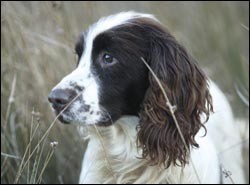Win CENS ProFlex DX5 earplugs worth £1,149 – enter here
Stereotypes: not all dogs conform to types
We can't change the genes, but nurture can help to develop certain traits in our dogs

Labradors are born half-trained – spaniels die half-trained, right? HPRs are strong-minded and chocolate Labradors are thick. Terriers fight anything with a pulse, and come to think of it, a pulse may not even be necessary. You can’t beat a good stereotype – sometimes justified, often not, or maybe the exception proves the rule. But what about those dogs that just don’t fit the popular perception of the breed? How much is down to nature and nurture?
Coming back from a Countryside March, I met a farmer who spoke about the number of dogs he’d had to shoot for sheep-worrying that year. Could I guess which breed troubled him most? My guess was wrong – it was Labradors.
Not “only playing” as their owners thought, this breed, universally understood to be soft-mouthed gundogs and family saints, morphed into efficient killers at a whiff of mutton. In fact, any dog will behave similarly – they are all dogs first, long before they are converted into different breeds, and it only takes opportunity for them to revert to the basic predator.
Breaking ranks
I know a brace of well-trained chocolate (there goes the stereoptype) Labradors that perform impeccably on shoot days unless they see a fox, whereupon they break ranks and hurtle after it. Fortunately, their lack of speed prevents any contravention of the 2004 Hunting Act, though this could loosely be termed “flushing to the gun”. Many of us have seen the footage of Fenton the Labrador lumbering after a herd of deer in Richmond Park. It is the natural dog versus the trained breed, and sometimes the wrong one wins.
Temperamentally, as well as physically, many breeds show a chasm of difference between show and working versions. This isn’t only due to deliberate breeding for stronger drives or a more phlegmatic nature, but (whisper it) the possibility of scandal in the family, either deliberate or accidental. While show dogs are much of a pattern, working versions can exhibit as many minor differences as a police identity parade, either due to an intentional illicit injection of outside blood for a specific purpose, or else the bitch knows something the breeder did not.
Inherited along with looks come traits, some of which are useful. But some, such as noise sensitivity, are unwanted. These may persist for many generations, lying dormant until they nick with a similar set of rogue genes on the other side to produce behaviour unexpected in that particular breed – because in truth, it hasn’t come from that particular breed. But sometimes the bloodlines are impeccable, and a specific incident at a critical time results in atypical behaviour. In this group I count, among others, the terrier that retrieved a family of young ratlings, alive and unharmed, to the sofa, the lurcher bitch on her first heat which displayed shamelessly to a horrified fox, and the greyhound that ran away from a rabbit and hid under the van.
All were juveniles; the terrier became a demon ratter, the lurcher a committed fox-killer and the greyhound a versatile working dog. But the nurture contribution was that each owner was unfazed by the aberrant behaviour and just let the dogs mature, where others would have labelled them “useless”.
Similarly, there was a stage in my life when I needed a terrier that would not go to ground. Though I went to see several jibbers and quitters, they each took one look at me and shot to ground (you can keep those remarks to yourself), baying, staying and mixing it to a degree that delighted their owners. The lesson? Some dogs need more time, especially if their job requires that insane courage needed in an earth dog. Once the pressure was off, the dogs performed. I never did find an above-ground-only terrier.
Health problems can make a dog appear to be out of character for its breed, and many a nervous Labrador, snappy spaniel or introverted terrier is actually unwell or in pain. Loss of confidence can affect any dog, but different types show it differently; bold ones become stroppy and quiet ones needy. Some aficionados can be in denial about certain characteristics – particularly in minority breeds – that only reveal themselves to the hapless first-time owner in the kind of company where they would have preferred to impress in a more conventional manner.
Coloured perceptions
Expectations and reputations so often colour our perception, and with a few breeds a dog is damned before it has done anything. For instance, I had to stop my lurchers from going beating because the behaviour of some of the Guns’ dogs would have been likely to unsteady them. Whereas the golden retriever chasing a deer into a lake brought guffaws of laughter, if one of my “poaching dogs” had done it, the reception would, I suspect, have been different.
Salukis are widely supposed to be stupid, but in truth they are clever, though not biddable, unless they think you are worth it. I know a saluki breeder whose entire house is secured with childproof locks and reversed door handles, because the dogs can open any normal fastening for any door or window. Border collies are without doubt the Einsteins of the canine world, but less well known is their tendency to irrational fears and phobias, or obsessive-compulsive disorders. This holds them back from world domination just as much as their lack of opposing thumbs. I think we should be grateful.
If a dog produces behaviour that appears unusual for the breed, we may deduce that its roots lie in its predecessors, and that a specific trigger brings it out. Sometimes, this is simply the way the dog is handled. We all know people who always have “good” dogs – and those whose dogs consistently disappoint them.
The dog might be good because it was bred from good stock and carefully chosen, or it might have been competently managed through various stutters in its training until it fulfilled its inborn potential in its own time. Some of the less bright breeds with a strong work ethic can appear stubborn, but a different trainer might seem to have found a rare “intelligent” one simply because they have more ways of creating a co-operative response. One person’s useless mutt can be another’s dog of a lifetime.
Changing from a stressful home to a quiet one can be the making of a dog that appeared disobliging, but was in fact overwhelmed by some situation that another dog would have taken in its stride. I have a dog on my books that has killed four other dogs, though she comes from a breed known for its gentleness. Re-homed to an exceptional dogman, she has never been a problem since; though her first owner’s care was exemplary, something in her previous environment had affected her and was producing extreme behaviour.
As with ourselves, the basic genetic blueprint cannot be changed, but environmental factors play a huge part in developing or retarding certain preexisting traits. Nature produces the basic dog and nurture colours it in. Now, has anyone seen that blasted terrier?
Other articles by Jackie Drakeford that you might like
Related Articles
Get the latest news delivered direct to your door
Subscribe to Shooting Times & Country
Discover the ultimate companion for field sports enthusiasts with Shooting Times & Country Magazine, the UK’s leading weekly publication that has been at the forefront of shooting culture since 1882. Subscribers gain access to expert tips, comprehensive gear reviews, seasonal advice and a vibrant community of like-minded shooters.
Save on shop price when you subscribe with weekly issues featuring in-depth articles on gundog training, exclusive member offers and access to the digital back issue library. A Shooting Times & Country subscription is more than a magazine, don’t just read about the countryside; immerse yourself in its most authoritative and engaging publication.







